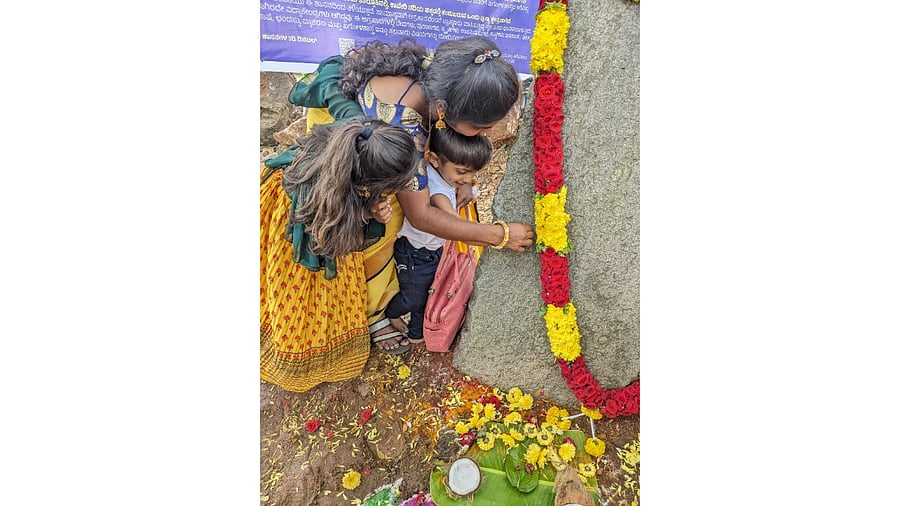
A woman traces the fingers of her child on an inscription at Gongadipura (near Bengaluru University) last year.
Credit: Udayakumar P L
Bengaluru: What ties Bengaluru's Pattandur Agrahara, Koramangala, Parappana Agrahara, and Binnamangala together? A piece of history dating back several hundred years ago.
Giving a fascinating peek into Bengaluru's past, inscriptions unearthed by researchers at The Mythic Society in some of these areas show that many 'agraharas' and 'mangalas' in the city were sites of well-organised residential educational institutions, much like small public universities.
For example, Agrahara Layout near Jakkur was mentioned in an inscription dating back to 1350 CE. In today's bustling Bengaluru, there are several international and public schools in the vicinity. The premier research institution Ashoka Trust for Research in Ecology and the Environment (ATREE) is located nearby.
Similarly, Parappana Agrahara, which is now the site of Karnataka's largest central prison, was most probably an educational institution once.
In total, the city's 23 agraharas and eight mangalas, which span the length and breadth of the city, were "self-sustained residential mini-universities", said Udayakumar P L, founder and project director (Honorary) of the Bengaluru Inscriptions 3D Digital Conservation Project at Mythic Society, Bengaluru.
"These institutions had designated teachers to teach specific subjects. There existed a credit system as well. Students would live and study in these agraharas and mangalas and also have access to fresh farm produce by farmers or woodwork through carpenters in the vicinity," he said.
One of the oldest records of an agrahara in the city was from Sarakki agrahara, with inscriptional evidence dating from as early as 900 CE. "Every school in Sarakki is continuing the tradition that began at least over a thousand years ago," he added.
Koramangala, too, was named in an inscription that is at least 1,124 years old. It is now a popular commercial destination in the city, with a few long-standing educational and medical institutions in the vicinity.
Similarly, Binnamangala, which is located in 1st stage, Indiranagar, was mentioned as a small centre for education as early as 1266 CE. Today, it is both a residential and a commercial area along the 100ft Road.
Although the conservation project has identified three inscriptions containing references to an agrahara and three naming a mangala, it is widely accepted that other areas in the city that have such a suffix must have also been sites of education.
Such inscriptional evidence not only reveals the origin of localities' names but also shows the city's deep-rooted connection to education.
Jakkur’s topper
When Udayakumar’s team visited Jakkur in 2019 to raise awareness among the local residents about inscriptions and the local history, he challenged them to read a Kannada inscription from the 10th century.
At that time, a young boy named Abhishek, son of migrant construction labourers from Raichur, who was studying in his 8th grade in a government school, volunteered to do so. “We were stunned to hear him read it so clearly and quickly that it seemed like only he knew the language,” said Udayakumar.
Five years later, in the recently declared results of this year’s pre-university exams, Abhishek has emerged as his government college’s topper in Arts.
Highlights - Agrahara Layout near Jakkur was mentioned in an inscription dating back to 1350 CE Koramangala was named in an inscription that is at least 1,124 years old Binnamangala, which is located in 1st stage, Indiranagar, was mentioned as a small centre for education as early as 1266 CE
Quote - These institutions had designated teachers to teach specific subjects. There existed a credit system as well. Students would live and study in these agraharas and mangalas and also have access to fresh farm produce by farmers or woodwork through carpenters in the vicinity - Udayakumar P L Project director (Honorary) of the Bengaluru Inscriptions 3D Digital Conservation Project
Cut-off box - Agraharas and mangalas Agraharas and mangalas which are synonymous terms were parcels of land given by merchants kings and other influential people to Brahmin communities in the city. This was done to enable Brahmins to establish self-sustaining religious-educational institutions with residential areas.